new posts in all blogs
Viewing: Blog Posts Tagged with: bird watching, Most Recent at Top [Help]
Results 1 - 9 of 9
How to use this Page
You are viewing the most recent posts tagged with the words: bird watching in the JacketFlap blog reader. What is a tag? Think of a tag as a keyword or category label. Tags can both help you find posts on JacketFlap.com as well as provide an easy way for you to "remember" and classify posts for later recall. Try adding a tag yourself by clicking "Add a tag" below a post's header. Scroll down through the list of Recent Posts in the left column and click on a post title that sounds interesting. You can view all posts from a specific blog by clicking the Blog name in the right column, or you can click a 'More Posts from this Blog' link in any individual post.
With days getting shorter and cooler, we often lament the coming of winter. When we move indoors it seems like we miss out on some of the creatures in the natural world. But, you can have birds in your yard all winter long by spreading out seeds and suet to attract them. Here’s Shiela Fuller’s recipe for HOMEMADE SUET:
HOMEMADE SUET for bird feeding
Feeding winter birds is a rewarding winter activity for adults and children. The general agreement is if you provide winter foods, you should also provide a water source and hiding places for protection from predators. This means, place your feeder near trees or bushes that give quick cover.
There are many different varieties of bird species to see right outside your window. Common seed eating varieties are the blue jay, tufted titmouse, and black capped chickadee. If you are lucky you might catch a glimpse of an Eastern towhee or yellow-rumped warbler passing through on migration. The insect eating winter birds such as the downy woodpecker, the red-bellied woodpecker, and the nuthatch especially enjoy suet.
Making your own healthy version of bird suet is so easy to do.
Gather the ingredients:
1. bacon fat (the leftover liquid fat after you’ve cooked it)-throughout the year collect the leftover fat in a jar and keep in your fridge.
2. rolled oats
3. peanut butter
4. dried fruits , nuts, and/or seeds
5. commercial bird seed
Process:
Combine one part bacon fat and peanut butter and melt in a saucepan. Add the additional ingredients to make a thick concoction.
Cool and pour into an empty box that give will your suet shape. A half gallon milk or juice carton is perfect for this. Place in freezer. 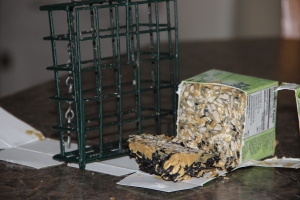 When solid, peel back the carton and slice the cake into ONE INCH THICK pieces that you can insert into your suet feeder or hang from a wire basket.
When solid, peel back the carton and slice the cake into ONE INCH THICK pieces that you can insert into your suet feeder or hang from a wire basket.
Keep the remaining suet in the freezer until needed. Since this has no artificial preservatives, recommended use is at 38* F or colder.
It won’t be long before the birds will make your backyard their home.
Shiela Fuller has been a Cornell University Project Feeder Watch participant for many years and an avid birder since 1988. Currently, she enjoys writing picture books, yoga, chicken raising, wildlife photography, and is the legacy keeper for her family.


By: Stacy Dillon,
on 8/11/2014
Blog:
Welcome to my Tweendom
(
Login to Add to MyJacketFlap)
JacketFlap tags:
dance,
bird watching,
Boston,
Depression,
Wendy Lamb Books,
Cape Cod,
running away,
arc from publisher,
neighborhoods,
9/14,
family crisis,
Add a tag
"I should have taken the shortcut home from my bird-watching spot at the salt marsh, because then I wouldn't have to walk past Joey Morell, whipping rocks against the telephone pole in front of his house as the sun goes down." (p. 1) If you know anything about me, I am a sucker for a good first line, and this one has got the goods.
This is Chirp's (Naomi's) story. Well, her family's story really. Her mom is a dancer who has suddenly started to have some problems with her body. Her leg is dragging around and has been hurting her for a while, but Chirp's somewhat clinical and distant psychiatrist dad isn't really talking about it. Big sister Rachel is distancing herself as well as she tries on teendom for the first time.
When Chirp's mom is diagnosed with MS the family verily falls apart. Hannah's existence has always been that of a dancer, and she quickly falls into a deep depression and nobody in the family really knows how to cope. Chirp finds an ally in a very unexpected person - Joey Morell.
Joey's family is one that Chirp's family looks down on. They have a 3 sons who run amok, but their problems go deeper than that. Chirp and Joey find common ground, and as two kids who ultimately are scared and feeling abandoned, they cement their friendship as they slowly reveal the pain inside each of their houses.
I don't want to spoil the plot so I will leave it there, but will also say that Ehrlich is part poet and part magician as she weaves this tale together. "Ice-blue quiet smacks me when I open the front door after school." (p. 86) "A little square of my blouse is stuck to my upper arm, like the wrinkly paper on a temporary tattoo before you lift it off and leave a splotchy red heart or yellow smiley face behind." (p. 164) "The air's already thick and warm, even though the sun's still just a spritz of light in the pitch pines and the scrub oaks and not a hot, round ball bouncing on the top of my head, like it will be soon." (p. 12) Swoon.
For sure, this is a story filled with heavy and heady stuff. But it is through the eyes of Chirp, so while it is indeed sad, it is never too much. It is gorgeous, quiet and filled with hope. I fell in love with Chirp and Joey as I read. They simply became real, and I turned the pages late into the night because I could not leave their story unfinished.
By: darlenebeckjacobson,
on 6/22/2014
Blog:
Darlene Beck-Jacobson
(
Login to Add to MyJacketFlap)
JacketFlap tags:
Children,
Nature,
Activities,
bird watching,
Outdoor activities,
summer fun,
Science activity,
Home Schooling Ideas,
caring for baby birds,
www.cedarrun.org,
Add a tag
It’s summer!
If you’ve maintained a wild bird backyard habitat throughout winter, you can continue through summer with added benefits. Providing food, water and shelter encourages birds to build a home and raise young when resources are plentiful. Fill a suet feeder with nesting supplies such as yarn threads, strands of hair, and broom bristles. Keep a part of your yard “natural” with a pile of leaves and pine needles, to offer a variety of supplies for birds to choose from. Keep your eyes out the window and take note to which birds make use of your materials.
Many birds will make their nest in close proximity to humans. Robins and mourning doves are known for making nests in shrubs, trees or on wooden ledges under decks. Swallows will build a nest from mud and attach it to the side of the house. Wrens love small bird houses and especially those that can safely swing in the breeze. Be on the lookout for neighborhood cats who like to lunch on unsuspecting baby birds. Snakes can also end the enjoyment of raising baby birds in your yard. I don’t recommend killing snakes as they also provide an important service in the ecosystem, but it’s never a good day, when a snake is found inside a nest box full of black-capped chickadees. 
In addition to prey, another hazard for baby birds is falling from the nest. If a baby bird found is very small and most likely dead, it has been pushed out by more aggressive siblings or from nest over load. If you find a baby bird that has feathers and can hop but cannot fly, it is most likely a fledgling, just learning to fly. Contrary to popular belief it is OK to pick up and replace the baby to its nest. Or, if it looks like the parents are attentive, leave it alone. If you cannot find the nest, place the bird in a tissue lined box in the same location in which it was found. Watch to see if the parents return to feed. Many do. If after a few hours you can’t be sure the parents are around, your best option is to take the baby to a local wildlife center. The people there will nurture the baby until it can survive on its own and usually return the bird to its original locale. 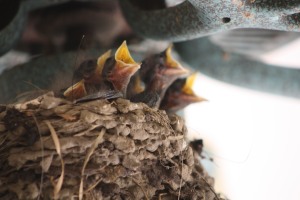
Woodford Cedar Run Wildlife Refuge is in southern New Jersey and takes in wildlife of all varieties.
6 Sawmill Rd, Medford, NJ 08055
(856) 983-3329
http://www.cedarrun.org
Another note of caution, be careful of tree cutting in the spring and summer. Many nests have been dislocated when unsuspecting tree cutters take down a bird’s summer home.
Taking care of our feathered friends can be a rewarding and enjoyable experience for young and old alike. Why not invite some birds into your backyard this summer?
Shiela Fuller has been a Cornell University Project Feeder Watch participant for many years and an avid birder since 1988. Currently, she enjoys writing picture books, yoga, chicken raising, wildlife photography, and is the legacy keeper for her family.


Now that summer vacation is here, why not try taking the kids for a real adventure by exploring nature’s wonders at a nearby forest or state park. These beautiful, natural areas are in every state and many have free activities for the whole family. Camping, hiking, bird watching, water sports, fishing and learning about plants and animals are some of the things you can discover at your local park, forest or nature preserve.
Visit: http://www.discovertheforest.org for tips on how to enjoy nature, how to be safe in wild areas, and DID YOU KNOW facts. All you have to do is enter your state and a list of all the forests and wildlife areas will appear. Discover your inner explorer by visiting a forest or natural area this summer. You won’t be sorry.
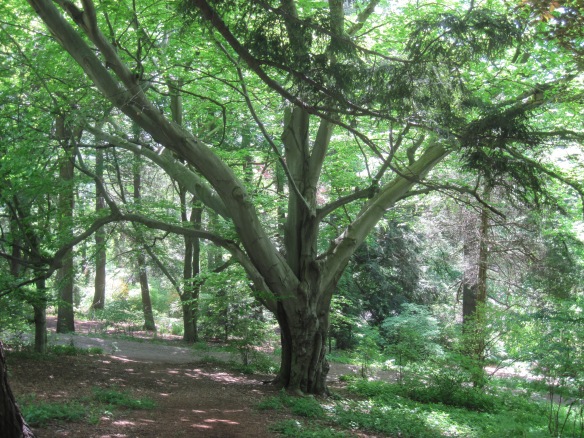
Boston Arboretum


By: darlenebeckjacobson,
on 4/24/2014
Blog:
Darlene Beck-Jacobson
(
Login to Add to MyJacketFlap)
JacketFlap tags:
Outdoor activities,
Science activity,
organic food/farms,
Home Schooling Ideas,
raising free range chickens,
Children,
Nature,
Activities,
bird watching,
Add a tag
My fellow writer and occasional visitor to this blog, Shiela Fuller is back with her wonderful post on how to raise your own free range chickens. Here’s Shiela:
Long before there were confined feeding animal operations (CAFO), people raised egg laying chickens in their backyards. As the inhumane treatment of mass produced farm animals for food becomes widely recognized, more individuals are turning to traditions of the past and again raising egg layers for their own use.
The instructions that follow for raising chickens are easy, but these are live animals that require care and supervision just as domestic animals do.
DOES YOUR MUNICIPALITY ALLOW FARM ANIMALS?
The prospective chicken owner must first research and determine if their municipality has regulations against the keeping of farm animals. If not, begin the search for a hatchery.
LOCATE YOUR NEAREST HATCHERY: Your two day old chicks will most likely be shipped by U.S. mail. A decreased distance from home to hatchery means your chicks will arrive quicker, less stressed and in better condition. Don’t be tempted to purchase the cute chicks you see for sale at your local farm and garden store. All chicks look alike at two days old, but at four months your cute chicks could grow up to look like this: 
WHEN TO ORDER
Plan to have your chicks arrive late spring/early summer. Order an egg laying breed such as the Rhode
Island Red or a mixed breed. Order your chicks with their beaks intact. You will have to ask for this as
hatcheries raise chicks by the tens of thousands and debeaking is done routinely as a matter of safety
and well-being for the large numbers that are kept in confinement.
HOW MANY TO ORDER: Order the number of chicks dependent on your available space. If your adult hens will free range on an acre, 15 chicks will be suitable. If you are limited to keeping your adult hens in a backyard enclosure, six chicks will be sufficient. Unless you plan to go into the business of selling eggs, 15 egg layers will create a sufficient supply. Once egg laying begins, hens routinely lay one egg per day for up to two years. They lay more productively in summer than winter, too. This is because egg laying is dependent on the number of daylight hours.
YOU’VE PLACED THE ORDER. You now have a delivery date. Call your post office and give them the information and your phone number. They will call you as soon as your chicks arrive.
WHILE YOU’RE WAITING: Assemble the things you will need to house your new arrivals. If you don’t have any of these items on hand or cannot borrow, purchase:
a large plastic tub with sides high enough that chicks cannot jump out, (for extra security a sheet of screen over the top will also help keep the chicks secure), a bag of cedar shavings, a heat lamp with a secure fastener, waterer, organic chicken crumbles.
Set up your chick’s housing in the location you have chosen. A warm kitchen, an out of the way mud room, or even the garage will be suitable. Place about three inches of cedar shavings in the bottom of the tub, securely fasten the heat lamp about 20 inches above the floor of the chick’s enclosure, put fresh cool water in the waterer, and offer plenty of crumbles.
THE CHICKS HAVE ARRIVED: The chicks will arrive in a ventilated cardboard box. Pick them up promptly from the post office and settle them into their new home. 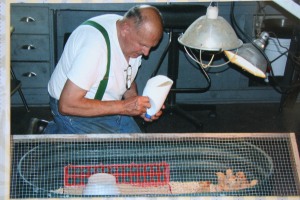
Pick each chick up individually and place them in their warm , draft free environment. Dip each chick’s
beak quickly in the water to induce drinking. This will also help “freshen” any chick that may have
arrived in an overstressed condition. Keep the food bowl filled as chicks eat constantly, and clean, as
chicks do not discriminate between the toilet area and feeding area. Pay attention to the comfort of the newly acquired chicks. Use the huddle indicator: If they huddle together, your lamp is too far from the chicks; if the chicks huddle in the corners, away from the heat source, the lamp is too close.
DAILY ROUTINE:
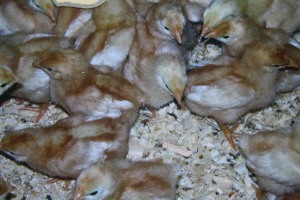 Maintain a bed of clean, dry shavings daily as it will become soiled from spilled water, food and excrement. The chicks will grow quickly and may need to be moved to a larger indoor container, such as a large dog crate. Use your judgement. By this time, you will feel accustomed to taking care of your chicks and will know when they are over crowed and need larger housing.
Maintain a bed of clean, dry shavings daily as it will become soiled from spilled water, food and excrement. The chicks will grow quickly and may need to be moved to a larger indoor container, such as a large dog crate. Use your judgement. By this time, you will feel accustomed to taking care of your chicks and will know when they are over crowed and need larger housing.
MOVING DAY: By about six weeks of age the chicks will have most of their feathers and if the outside temperature is warm, they can be moved to their outdoor location.
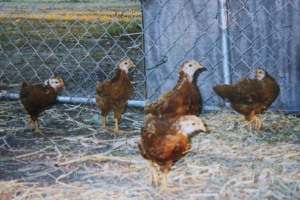 Much care needs to be taken as to the safety of your flock. Opportunistic predators such as snakes, hawks, owls, and foxes love captive prey. Even chicks that will eventually free range will need a place for safe keeping at night time.
Much care needs to be taken as to the safety of your flock. Opportunistic predators such as snakes, hawks, owls, and foxes love captive prey. Even chicks that will eventually free range will need a place for safe keeping at night time.
OUTDOOR HABITAT: For a small flock of confined hens or a free range flock that need a safe keeping place,a suitable arrangement can be made from the following items:
an 10 x 10 outdoor dog kennel, or larger; an outdoor dog house, plastic netting for a cover, fresh hay for filling house and box, egg laying box, perching area, organic egg layer pellets and water bowl.
Dig an area 10 x 10 in diameter and drop your kennel into the earth. This aids in keeping the digging predators, like foxes from gaining entrance and eating your hens. Cover the enclosure with netting to keep out the flying predators. After four months of age, the hens will have grown too large for snakes to consume, so they become less of a problem.
The egg laying boxes, feed bowls, and waterer, the perching area below. 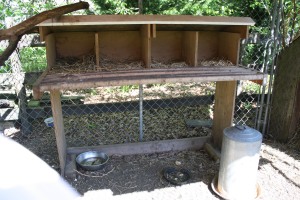
The housing is made from a dog box and plastic cover.
Congratulations! You have successfully raised chicks to egg laying hens. You will make mistakes and learn more as you move along in your chicken adventure. Some additional facts:
—Chickens will eat much more than crumbles and pellets. Offer them seeds, produce and vegetable leftovers, both cooked and uncooked. Free range hens will also consume baby birds, mice and toads. Chickens have individual food preferences.
—Once your free range chickens are accustomed to their new outdoor accommodations, free them in the morning and near dusk they will (they should) return to the enclosure to be locked in for safe keeping at night.
—A rooster is not necessary for egg layer success.
—The chickens will eventually see you as their food source and will run to you upon calling them.
—As was said earlier, snakes are not a problem once your chicks are too large to be consumed, but at some point you may be startled to find one in your hen enclosure:
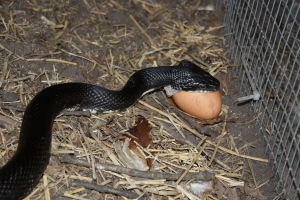 Keep in mind snakes are an important part of the ecosystem. You can spare an egg or two!
Keep in mind snakes are an important part of the ecosystem. You can spare an egg or two!


By: darlenebeckjacobson,
on 3/30/2014
Blog:
Darlene Beck-Jacobson
(
Login to Add to MyJacketFlap)
JacketFlap tags:
Outdoor activities,
Science activity,
osprey migration,
www.jamaicabayosprey.com,
www.njaudobon.org,
www.nyharborparks.org,
Children,
Nature,
animals,
bird watching,
web sites,
Add a tag
Now that spring is showing us some signs that it just might stay awhile, have you ever wondered how birds know – sometimes before we do – that the weather is warming up and it’s okay to hang around? My writer, scrapbooking, and nature loving friend Shiela Fuller is back with a very interesting post about Ospreys that sheds some light on that question.
Each year since May 2012, wildlife biologists have been studying the migratory track of two adult ospreys from the Jamaica Bay Wildlife Refuge in Queens, New York to their wintering site in South America. Queens is the easternmost of five New York City boroughs and the second most populated. The main goal of the project was to gain public awareness of the refuge and cultivate interest in the inhabitants that live there.
The first osprey outfitted with a transmitter was Coley. During the summer of 2012 his movements were monitored 12 hours a day. He began his winter migration and headed south on September 10th, 2012. Seventeen days and 2600 miles later, Coley arrived at his winter home, Columbia, South America.
On May 5, 2013, Coley began his round trip back to Queens, NY and he arrived in 15 days and 7 hours.
Later in the month, Coley’s transmitter was removed and placed on another male osprey, Coley 2. Scientists would now track the movements of this bird. During the summer, Coley 2 spent a lot of time perched with his mate after nest failure. Staying close to the nest assured the pair that it would still be their home the following spring. 
Weather can affect migration and when Coley 2 left New York on September 2, 2013, he was headed into some pretty serious thunderstorms. He only traveled 44 miles and settled in Trenton, New Jersey for the first night of his trip. Coley 2 continued onward and made remarkable time considering his damp start. He arrived at his winter home, Lake Valencia in Venezuela, South America on September 17, 2013.
While at Lake Valencia, Coley 2 will spend his time fishing, eating, and resting until his internal signal tells him it is time to return to the nesting area.
What inspires birds to migrate north or south and how do they find their way? There are only scientific speculations but some say it is hormonal changes and/or the changes in the length of day/night hours that motivate migration. Navigation is a bit trickier to understand but some say birds rely on the position of the sun, those that travel at night rely on the North Star, and some scientists say that birds use landmarks to help them find their way just as humans do. That doesn’t explain a bird’s first migration. How would they know the landmarks if they never traveled before?
Scientists had been monitoring Coley 2 at Lake Valencia and were happy to note that he must know the weather is bad in the northeastern US and stayed a little longer at his warm winter home but on Sunday, March 16, 2014, just a few days ago, Coley 2 left and was traveling at a remarkable 250 miles per day. 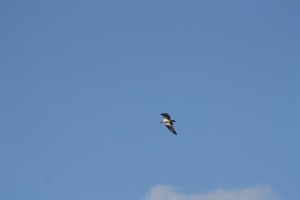
Scientists are not monitoring Coley 1, but he and his female partner were spotted on their platform nest in Jamaica Bay on March 23, 2014. Will Coley 2 be far behind? Will his female partner arrive before he does? Follow Coley 2 on his magnificent journey and you can even predict when he might arrive at his summer home: http://www.jamaicabayosprey.org.
For more details about the National Parks of New York Harbor Conservancy osprey project and to predict when Coley 2 will arrive go to: http://www.jamaicabayosprey.com http://www.nyharborparks.org
Footnotes: Another fabulous place to visit is the Cape May Bird Observatory. Their website for information is: http://www.njaudobon.org


So I normally post about trends I see happening in YA, but here's a trend that is happening across the board: bird watching. It took me by surprise-who knew bird watching would become so book trendy? But check it out:
Childrens:
Middle Grade:
(not totally about bird watching, but features bird watching characters)
(This one appears to be self published, which I don't typically include,but I thought it was interesting how it fit the theme)
Young Adult:
Adult:
Have you noticed birds in your books lately?
 A little black leather-bound mystery fell into my lap today. My friend Marjie, another English teacher in my school, handed me the journal 9th period. A student's father had found it in the trees alongside a trail when he was hiking in the Adirondacks. They looked for a name. Nothing. They read bits and pieces of it but couldn't figure out who might have left it in the woods.
A little black leather-bound mystery fell into my lap today. My friend Marjie, another English teacher in my school, handed me the journal 9th period. A student's father had found it in the trees alongside a trail when he was hiking in the Adirondacks. They looked for a name. Nothing. They read bits and pieces of it but couldn't figure out who might have left it in the woods.
I opened the front cover and saw this.

The journal was filled (half-filled, actually) with beautiful sketches, poems, and thankfulness for the role that nature plays in grounding us when we need it the most. But no name. No clues. Just lovely pencil sketches and descriptions of the moss, the ferns, the pitcher plants in the bog. It is lovely. And homesick, I can tell. This journal needs to get back to its owner.
Here's our best hope. At the end of each entry was a date and the name of the trail the writer hiked that day. The Department of Environmental Conservation leaves log books at the trailheads of many Adirondack hikes. Did this hiker sign the logs? I took the journal home tonight, and my kids are on the case now, too. We'll be hiking this weekend, following Mystery Writer's trail and checking the log books to see who hiked on those days. I'll post a progress report next week!
Saturday is usually a very good day to go to the woods. The village and surrounds become deserted as the Great British public indulge in their favourite pastime, shopping. I had intended to get on with some new work for my soon-to-be Etsy shop, but the lure of a clear blue sky and sunshine was too much. Grabbing my combat boots and fleece, I raced Hercules down the road and away to our local nature reserve. My prediction was wrong - there were several people in the front of the woods, shouting and 'coo-eeing' (bye-bye wildlife), but I quietly pottered away towards the back, and found myself blissfully alone. Moving stealthily through the pinewoods, I surprised a trio of hinds. They danced silently away in a graceful arc, and I rotated to watch them as they circled and disappeared. The woods may seem to be just another part of human territory, but as soon as you enter its environs, you are being watched and heard by myriad beady eyes and pricked ears. The forest folk know you are there, and you have little chance of seeing them unless you move as cautiously as they. The blackbird is nature's watchdog, and his alarm call warns all that a stranger is approaching - beware, beware!
Unless it is raining, I wear soft clothes - no tell tale anorak rustling - and tread firmly but softly, avoiding sticks. Every so often I stop stock still and just listen. After a few minutes, birds start to rustle about, and the life of the woodland starts up again. Stand there even longer and who knows what you may see? A fat rabbit scuttles across the path and a quicksilver squirrel abandons its fir cone and darts to the safety above. Look behind you - is there a small creature furtively creeping away from you, thinking your back is turned? A young buzzard cries its high pitched 'kai, kai', sweeping overhead like a young lord, and a pair of panicked wood pigeons flap clumsily in a flurry of stupidity.
Just as I was taking a homeward footpath. I heard a hollow drumming; a woodpecker. It was soon followed by a second and then a third - one higher, the other lower, the threesome sounding for all the world like a percussion band. Slowly heading in their direction, I noticed yet another deer, a solitary buck, much bulkier and camouflaged amid the trees. His stocky brown body was just about visible if you knew what you were looking at. But if not, he was just the dark space between the trunks. The drumming came and went. I stood still, and listened, scanning the treetops and was rewarded with a flash of brilliant scarlet - a Greater Spotted Woodpecker, crawling about the topmost branches, digging in the bark with its beak for insects. It seemed not to have seen me, and I watched it entranced, thrilled at this rare privilege. I did try to get a photo, but my little camera could only zoom in to this red smudge.

'it's in there somewhere...'
After about ten minutes it flew off. I moved on, trying to find the other two still tapping away, and couldn't believe my luck when I spotted another - and a few second later, it was joined by its' mate. If only I had brought the binoculars...the pair fluttered off and so did I. More of a slow splodge in the mud than a flutter, but still glowing with my afternoons' encounters - much more exciting than shopping. For more on this, see the post below.
 When solid, peel back the carton and slice the cake into ONE INCH THICK pieces that you can insert into your suet feeder or hang from a wire basket.
When solid, peel back the carton and slice the cake into ONE INCH THICK pieces that you can insert into your suet feeder or hang from a wire basket.















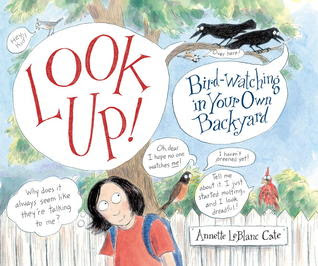
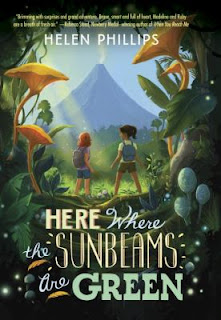
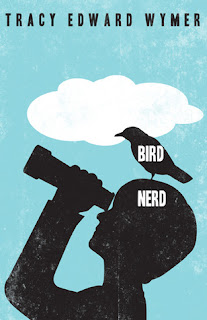


 A little black leather-bound mystery fell into my lap today. My friend Marjie, another English teacher in my school, handed me the journal 9th period. A student's father had found it in the trees alongside a trail when he was hiking in the Adirondacks. They looked for a name. Nothing. They read bits and pieces of it but couldn't figure out who might have left it in the woods.
A little black leather-bound mystery fell into my lap today. My friend Marjie, another English teacher in my school, handed me the journal 9th period. A student's father had found it in the trees alongside a trail when he was hiking in the Adirondacks. They looked for a name. Nothing. They read bits and pieces of it but couldn't figure out who might have left it in the woods.


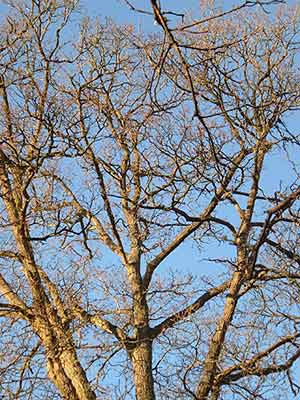
Feeding winter birds is really a rewarding winter activity…